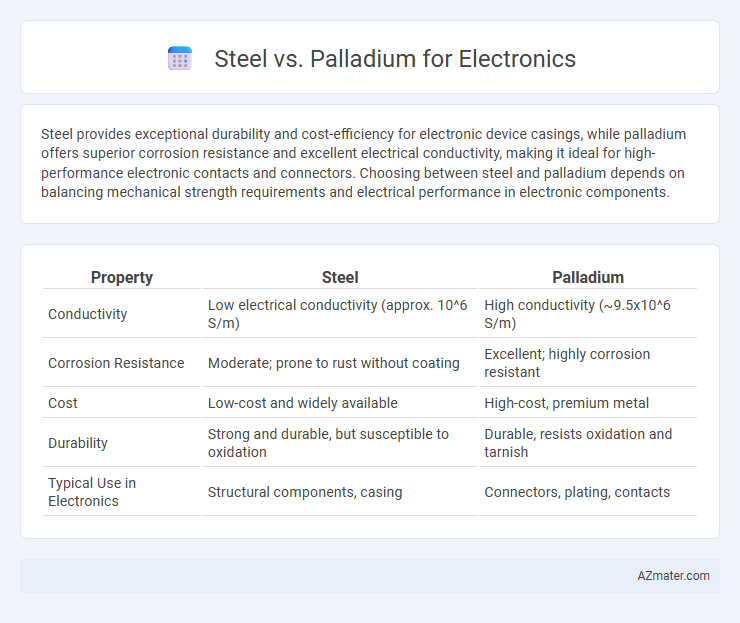Steel provides exceptional durability and cost-efficiency for electronic device casings, while palladium offers superior corrosion resistance and excellent electrical conductivity, making it ideal for high-performance electronic contacts and connectors. Choosing between steel and palladium depends on balancing mechanical strength requirements and electrical performance in electronic components.
Table of Comparison
| Property | Steel | Palladium |
|---|---|---|
| Conductivity | Low electrical conductivity (approx. 10^6 S/m) | High conductivity (~9.5x10^6 S/m) |
| Corrosion Resistance | Moderate; prone to rust without coating | Excellent; highly corrosion resistant |
| Cost | Low-cost and widely available | High-cost, premium metal |
| Durability | Strong and durable, but susceptible to oxidation | Durable, resists oxidation and tarnish |
| Typical Use in Electronics | Structural components, casing | Connectors, plating, contacts |
Overview: Steel vs Palladium in Electronics
Steel and palladium serve distinct roles in electronics, with steel primarily used for structural components and casings due to its strength and durability, while palladium is valued for its excellent conductivity and corrosion resistance in connectors and contacts. Palladium's resistance to oxidation ensures reliable performance in sensitive electronic circuits, especially in multilayer ceramic capacitors and plating applications. Steel is favored in electronics for mechanical support and shielding, but palladium's superior electrical properties make it critical for high-performance and miniaturized electronic devices.
Material Properties and Composition
Steel, primarily composed of iron with carbon and other alloying elements, offers high strength, durability, and magnetic properties crucial for structural components in electronics. Palladium, a rare precious metal in the platinum group, provides excellent corrosion resistance, superior conductivity, and catalytic properties, making it ideal for connectors, capacitors, and plating in electronic devices. The contrasting material compositions influence their application, with steel favored for mechanical support and palladium preferred for conductive and protective roles within electronic circuits.
Electrical Conductivity Comparison
Palladium exhibits significantly higher electrical conductivity compared to steel, making it a preferred choice for sensitive electronic components requiring reliable signal transmission. Steel's conductivity is lower due to its iron-carbon alloy composition, limiting its effectiveness in high-performance electronic circuits. Palladium's superior resistance to corrosion and oxidation further enhances its conductivity longevity in electronic applications.
Corrosion and Oxidation Resistance
Palladium exhibits superior corrosion and oxidation resistance compared to steel, making it a preferred choice for high-reliability electronic components exposed to harsh environments. Its noble metal properties prevent tarnishing and oxidation, ensuring long-term electrical conductivity and signal integrity. Steel, while stronger and more cost-effective, requires protective coatings or treatments to mitigate rust and oxidation, limiting its use in sensitive electronic applications.
Cost and Market Availability
Steel, known for its affordability and widespread availability, remains a cost-effective choice in electronics manufacturing, particularly for chassis and structural components. Palladium, although significantly more expensive due to its rarity and demand in catalytic converters and electronic connectors, offers superior corrosion resistance and electrical conductivity. The limited market availability of palladium, driven by supply constraints and geopolitical factors, often leads to price volatility, making steel a more stable option for cost-sensitive applications.
Mechanical Strength and Durability
Steel offers superior mechanical strength and durability for electronic components, providing excellent resistance to deformation and wear under heavy mechanical stress. Palladium, while highly corrosion-resistant and effective for thin-film coatings, lacks the robust hardness of steel, making it less suitable for structural parts requiring high mechanical endurance. The combination of steel's tensile strength and fatigue resistance ensures longer lifespan and reliability in demanding electronic applications.
Applications in Electronic Devices
Steel is commonly used in electronic devices for structural components and enclosures due to its durability, magnetic properties, and cost-effectiveness. Palladium excels in electronic applications primarily as a key material in multilayer ceramic capacitors and as a plating material for connectors and contacts, providing excellent corrosion resistance and superior electrical conductivity. The choice between steel and palladium depends on the specific device requirements, with palladium preferred in high-performance, miniaturized electronics requiring reliable, low-resistance connections.
Environmental Impact and Sustainability
Steel, widely used in electronics for structural components and enclosures, has a significant environmental footprint due to energy-intensive mining and smelting processes, yet it benefits from high recyclability and an established global recycling infrastructure. Palladium, essential in electronic connectors and catalytic converters, carries a substantial environmental cost linked to limited supply, mining scarcity, and hazardous extraction methods, making it less sustainable despite its critical performance characteristics. Sustainable electronics design increasingly favors steel for its recyclability, while efforts to reduce palladium use or develop alternatives aim to mitigate the environmental impact of rare metal dependency.
Lifecycle and Recyclability
Steel in electronics offers durability and is highly recyclable, with recycling rates exceeding 80%, contributing to a sustainable lifecycle by reducing raw material extraction. Palladium, a precious metal used in electronic components for its excellent conductivity and resistance to corrosion, has a more limited availability and lower recycling rates around 30-40%. The lifecycle of steel supports circular economy principles through effective reuse and recycling processes, while palladium's rarity necessitates careful recovery efforts to minimize environmental impact and maintain supply security.
Choosing the Right Metal for Electronics
Steel offers high strength and durability with excellent corrosion resistance, making it ideal for structural components and enclosures in electronics. Palladium excels in electrical conductivity and oxidation resistance, often used in connectors and contacts to ensure reliable signal transmission. Selecting the right metal depends on balancing mechanical requirements and electrical performance for optimal device functionality.

Infographic: Steel vs Palladium for Electronics
 azmater.com
azmater.com